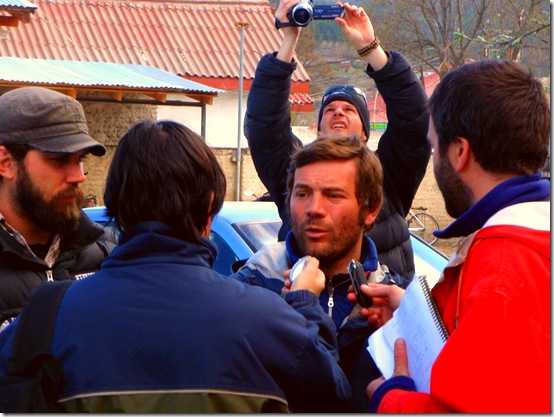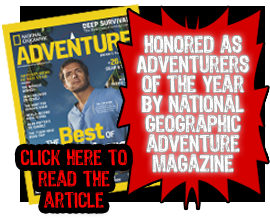When it comes to driving around the world, obviously there are several different routes you can take because as far as I know, there is no one official path to take. I assume that if you make it a full 360 degrees from east to west, or from west to east, you can lay claim to driving around the world, barring of course the time and distance that you and your vehicle(s) spend crossing the bodies of water that lay in between. On our particular expedition, we are covering the appropriate east-west distance to fulfill our goal of driving around the world but in the process, we are also deviating quite a bit north of the equator and quite a bit south. Currently, we are in Ushuaia, Argentina which represents just about the southern most point in the world you can drive with a vehicle. Technically, Puerto Williams, Chile on the other side of the Beagle Channel from Ushuaia is the southern-most settlement in the world, but to spare you from going into detail on a sometimes contentious debate between Argentina and Chile, we will still consider Ushuaia to be the southernmost city in the world, lying at about 55 degrees south latitude.
So, we have driven to the end of the world as they like to call it here, but why not take it a bit further? It just so happens, that there is a scuba diving operation in Ushuaia, Ushuaia Divers, and they will gladly take you out into the icy depths of the Beagle Channel, beyond the limits of Ushuaia, for an underwater experience that you can not really get anywhere else. Carlos is a local who has run the dive operation in Ushuaia for more than 15 years and he was kind enough to take us out on an unusually pleasant spring morning and help us go a little bit beyond the end of the world… under it.
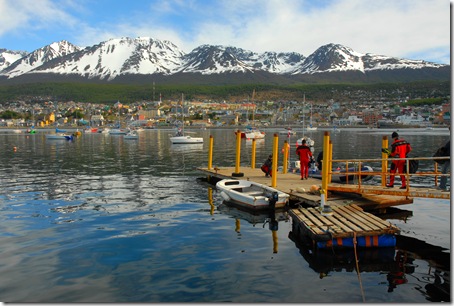
Snow and scuba diving… not necessarily a good mix
Scuba diving this far south presents some very unique challenges to divers of any skill set. Heading up the list of these challenges is, without a doubt, the water temperature. At five degrees (Celsius), venturing into water this cold for an extended period of time can be fatal, so extra steps are needed to ensure that instead of appearing to have suicidal tendencies, you are actually going in the water to enjoy yourself. A dry suit is the primary measure of protection in cold water scenarios, and at around $2,000 a pop, they are expensive, but it is hard to put a price on your life I guess. It was the first time Shoppman and I had ever used a dry suit in our diving experiences and it took a little getting used to. However, once you learn how to avoid having the dry suit cut off the circulation to your limbs and feeling like you are being vacuum sealed in shrink wrap, you are actually quite comfortable in the frigid waters. To avoid being crushed by the dry suit as a result of the surrounding water pressure and to avoid shooting up to the surface like a cork, you must regulate the airflow going into and out of the dry suit depending on the depth of the water you are in. This all takes some degree of skill on top of paying attention to all of the other factors when you are diving and judging by the marks and bruises on my arms and legs, it is obvious I need a lot more practice at using a dry suit.
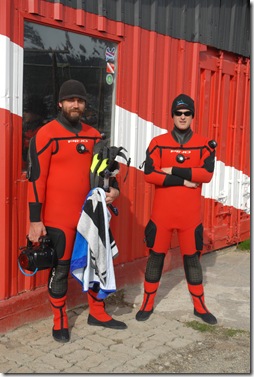
Suited up and ready to go
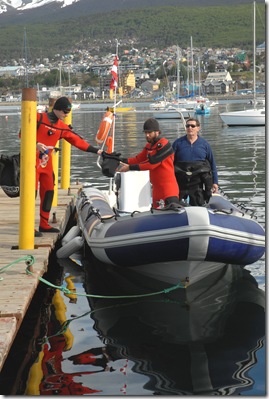
Prepping the boat for the dive
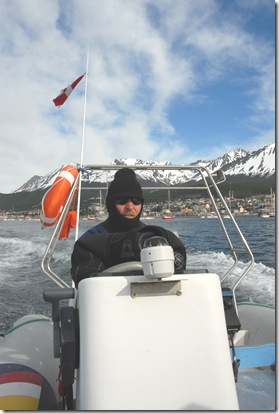
The way Carlos was dressed made us feel like we were embarking on a special forces mission
Diving in the icy waters of the Beagle Channel is sort of a novelty, but you do get the privilege of observing some aquatic life that you do not get to see in most other diving environments. Visibly, there appears to be a lot less sea life here than compared to your typical tropical reef, but it is not that often that you get to swim face to face with giant King Crab, venture through giant forests of kelp and on the odd occasion, soil your dry suit at the sight of a curious sea lion or penguin zipping by to check you out. There are also quite a few underwater wrecks to explore in the channel, but doing so requires good conditions and when you are this far south, the weather is about as predictable as the stock market these days.
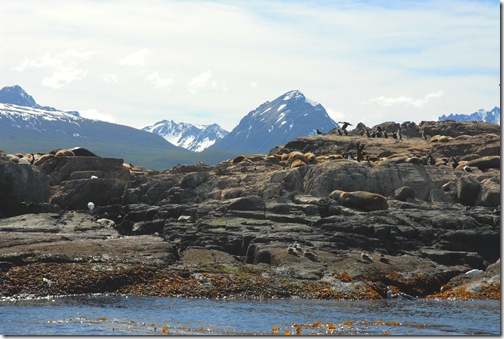
Seal lions and penguins are the only tourists enjoying the beach in Tierra del Fuego
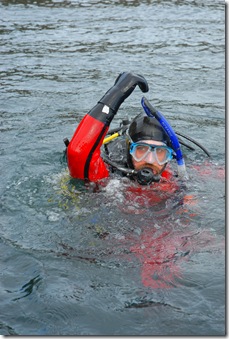
Shoppman signals that he can’t feel his head anymore
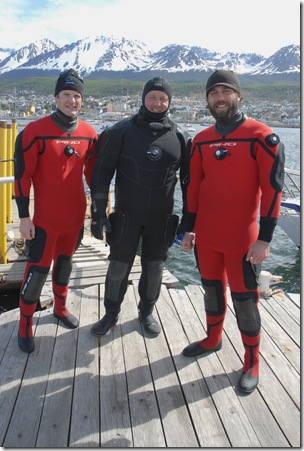
Standing on the dock in Ushuaia harbor convincing people we are out of our minds
At the end of the dive, part of my mind was thankful to be back on the boat in the comparatively warm nine degree (Celsius) air but at the same time, another part of it was ready to get back in the water. It is an experience that is definitely not for everyone, and I am grateful to Carlos for giving me the opportunity to dive in arguably one of the more extreme environments in the world. When we were not fumbling around with our dry suits, we were actually filming the dive so stay tuned for a video segment highlighting our day with Ushuaia Divers.
INSERT_MAP








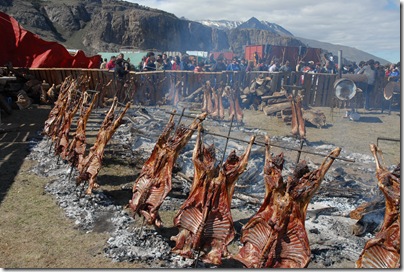 We, on the other hand, went to bed with the cake still in our stomachs at a campground and woke to a wonderful view of Fitz Roy.  It was a gorgeous spring day that brought tourists and locals alike all with one thing in mind: the Asado.  We have mentioned our affinity for Argentine asado, and surely an asado of this caliber is unlikely to be seen outside the Argentine political borders. The asado area, marked by makeshift fence, contained roughly 20 chorizo grills and no less than 30 lambs on the aforementioned crucifix with one large steer hoisted up in the same manner. The sight and smells alone were more than enough for a 500 hundred person mob to gather within minutes…actually, to be fair, several hundred were crowding the fences to the pit about an hour before the first dish was handed out.Â
We, on the other hand, went to bed with the cake still in our stomachs at a campground and woke to a wonderful view of Fitz Roy.  It was a gorgeous spring day that brought tourists and locals alike all with one thing in mind: the Asado.  We have mentioned our affinity for Argentine asado, and surely an asado of this caliber is unlikely to be seen outside the Argentine political borders. The asado area, marked by makeshift fence, contained roughly 20 chorizo grills and no less than 30 lambs on the aforementioned crucifix with one large steer hoisted up in the same manner. The sight and smells alone were more than enough for a 500 hundred person mob to gather within minutes…actually, to be fair, several hundred were crowding the fences to the pit about an hour before the first dish was handed out. 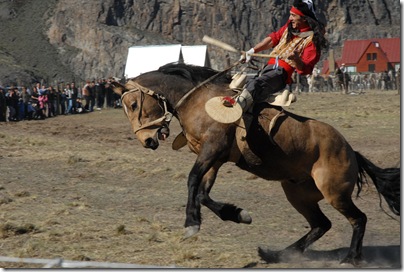 Clearly more than a few people knew what they were doing since they were smart enough to bring their own dishes, carving knives and even cutting boards. Had we known the dire straights of the serving procedure, suckers like Bouey and myself would not have been among the last to eat the remaining pieces of unspecified cuts of meat with our bare hands.  We admitted defeat and turned to the gaucho rodeo to lift our spirits.  And let me tell you, just one look at a true Patagonian gaucho decked out in his fancy gaucho best will have you forgetting getting ripped off at the asado for at least several minutes. Guachos of all ages were displaying their ranching abilities- namely breaking wild broncos and mustangs- in the face of a well sated and roaring crowd for the rest of the afternoon.
Clearly more than a few people knew what they were doing since they were smart enough to bring their own dishes, carving knives and even cutting boards. Had we known the dire straights of the serving procedure, suckers like Bouey and myself would not have been among the last to eat the remaining pieces of unspecified cuts of meat with our bare hands.  We admitted defeat and turned to the gaucho rodeo to lift our spirits.  And let me tell you, just one look at a true Patagonian gaucho decked out in his fancy gaucho best will have you forgetting getting ripped off at the asado for at least several minutes. Guachos of all ages were displaying their ranching abilities- namely breaking wild broncos and mustangs- in the face of a well sated and roaring crowd for the rest of the afternoon.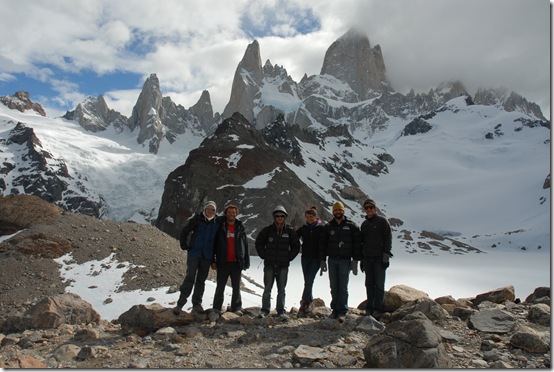
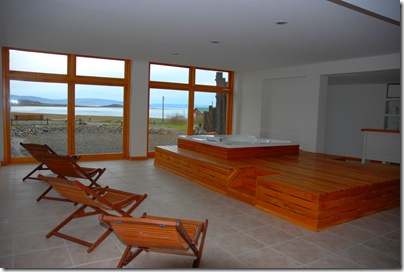 After finally stopping for the night at 3am and camping in a dried-up lake bed, which can more appropriately be described as the planet Mars, we woke and drove the last 300km to El Calafate. Nowadays with an increasing influx of tourists, the town of El Calafate is more similar to ski resort town Park City, Utah than any other southern Argentine town. We were immediately welcomed at
After finally stopping for the night at 3am and camping in a dried-up lake bed, which can more appropriately be described as the planet Mars, we woke and drove the last 300km to El Calafate. Nowadays with an increasing influx of tourists, the town of El Calafate is more similar to ski resort town Park City, Utah than any other southern Argentine town. We were immediately welcomed at 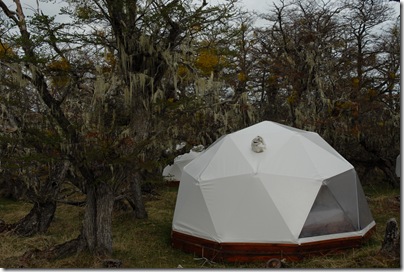 There is absolutely no way anyone would ever be able to happen upon this camp without them to guide you through 10 not-so-well-marked kilometers or the 8 separate gates. By the 5th gate or so, you realize that you are truly in for something special. By the last gate, you’re able to get your first glimpse of the glacier and by the time you park about 30 minutes later, you can see their geodesic sleeping domes tucked down below among fairy tale like trees not uncommon to the filming locales of Lord of the Rings. By day we each took our time wandering alone and secluding ourselves in the Patagonian wilderness, and by night, we gathered around the fire while Eduardo prepared meals of local traditional favorites.
There is absolutely no way anyone would ever be able to happen upon this camp without them to guide you through 10 not-so-well-marked kilometers or the 8 separate gates. By the 5th gate or so, you realize that you are truly in for something special. By the last gate, you’re able to get your first glimpse of the glacier and by the time you park about 30 minutes later, you can see their geodesic sleeping domes tucked down below among fairy tale like trees not uncommon to the filming locales of Lord of the Rings. By day we each took our time wandering alone and secluding ourselves in the Patagonian wilderness, and by night, we gathered around the fire while Eduardo prepared meals of local traditional favorites.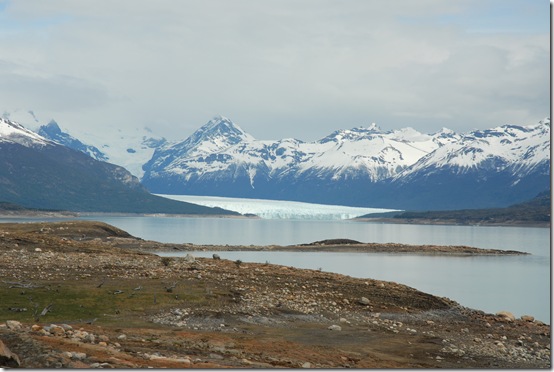
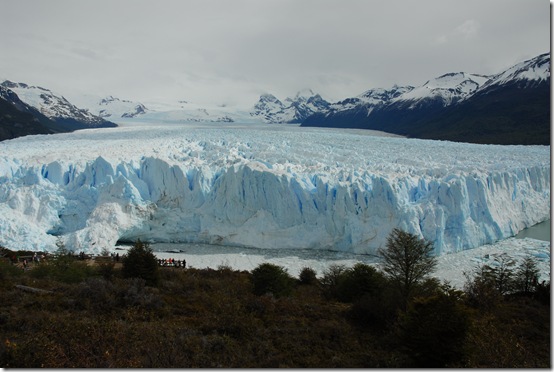
![coloradohealth[1]](http://www.theworldbyroad.com/expedition/wp-content/uploads/2008/10/coloradohealth1.jpg)
